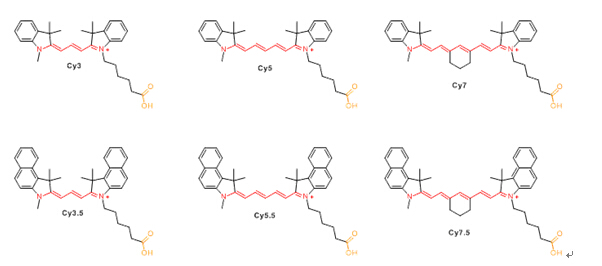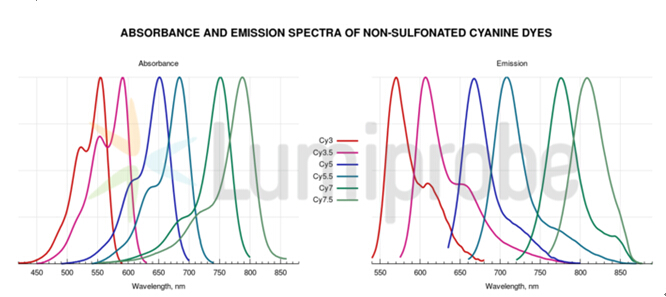Cyanine Dyes - US Lumiprobe
The dyes of cyanines contain a conjugated chain consisting of a group of (CH)n, and n can be odd or even. A heterocyclic ring, an aromatic ring compound, a cycloolefin compound or the like is bonded to a conjugated chain at both ends or a chain of the conjugated chain, and the hydrogen inside the molecule may be substituted by a certain number of various substituents.

Many Cyanine dyes have been used in the life sciences, and a range of thiazole and oxazole dyes have been used for DNA and protein staining (eg TOTO, YOYO, Stains All and others). But the most popular cyanine dyes in life science research were discovered by Alan Waggoner of Carnegie Mellon University and his colleagues in the early 1990s. The cyanine dye is a modified indocyanine green (ICG) that has been used for angiography since the 1970s and both contain two false ankle ring flanking (CH) n chains. These dyes have been found to exhibit low non-specific binding to biomolecules due to the large extinction coefficient that produces bright fluorescence and good quantum yield. Once patented, these molecules are available in the public domain after the Carnegie Mellon patent expires and are available from Lumiprobe as a variety of reactive derivatives for research and commercial applications, such as NHS esters for click chemistry, horses. Derivatives of imides, azides and other derivatives.
There are two types of cyanine dyes: non-sulfonated cyanine dyes and sulfonated cyanine dyes. For many applications, they are interchangeable because their spectral properties are almost identical. Sulfonated and non-sulfonated dyes can be used for the labeling of biomolecules such as DNA and proteins. The difference between the two dyes is their solubility: sulfo dyes are water soluble, they can be labeled in an aqueous environment without the addition of organic cosolvents, and they are more dispersible in water. In some cases, you may only need one of these two dyes (the specific differences between non-sulfonated cyanine dyes and sulfonated cyanine dyes are detailed below).
Non-sulfonated cyanine dye

The fluorescence properties of the non-sulfonated cyanine dyes are less dependent on the solvent and the reaction environment, and the absorbance and fluorescence spectra of the non-sulfonated cyanine dyes are plotted below.

Sulfonated cyanine dye
Sulfonated cyanine dyes contain additional sulfo functional groups that promote the solubility of dye molecules in the aqueous phase. Charged sulfonates reduce the degree of polymerization of the dye molecules and label the conjugate well.
Currently available sulfonated cyanine dyes include sulfo-Cy3, sulfo-Cy5 and sulfo-Cy7.

Sulfonated cyanine dyes are highly water soluble. No bio-solvent assist is required to label biomolecules.
Similarities and differences between sulfonated and non-sulfonated cyanine dyes
Both sulfonated and non-sulfonated cyanine dyes exhibit very similar fluorescent properties. However, there are several differences in the instructions for use. Note that non-sulfonated cyanine dyes must first be dissolved in an organic cosolvent (DMF or DMSO) and then added to the target biomolecule solution with the appropriate aqueous buffer. The recommended volume of cosolvent is to dissolve Cy3, Cy5, Cy7 using 10% cosolvent, and .5 dye using 15% cosolvent. Sulfonated cyanine dyes can be used in pure water environments. Regarding the difference in purification of cyanine dyes: When using dialysis to purify dyes associated with water or water-soluble buffer solutions, sulfo-Cy must be used to achieve efficient removal of unreacted dye materials. The reaction with the sulfonated and non-sulfonated cyanine dyes can be carried out by gel filtration, chromatography (FPLC, high performance liquid chromatography, ion exchange), or electrophoresis.

Sulfonated and non-sulfonated cyanine dyes are interchangeable when labeling the following categories of targets:
1. Soluble protein, which is resistant to additional organic co-solvents
2. Antibody (using 5 - 10% DMSO / DMF)
3. DNA and oligonucleotides
4. Peptide
5. Many small molecules
Note: The fluorescent properties of conjugates labeled with sulfonated and non-sulfonated reagents (eg, sulfo-Cy5 and Cy5) are very similar and can be used in a variety of fluorescent instruments.
Sulfonated cyanine dyes must be used in the following cases:
1. Sensitive proteins denatured by DMF or DMSO
2. Purified protein conjugate by dialysis
3. There are nanoparticles in the aqueous solution
4. Insoluble in water or hydrophobic proteins
Non-sulfonated cyanine dyes must be used in the following cases:
Reaction occurring in the organic phase (dichloromethane, nitrile methane)
Kaiwei Yicheng is the agent of Lumiprobe in the United States. In addition to the cyanine dyes, as well as animal living imaging dyes, please consult 4008100506.
Pain Relief Patch for Breast
[Name] Medical Cold Patch
[Package Dimension] 10 round pieces
The pain relief patch is composed of three layers, namely, backing lining, middle gel and protective film. It is free from pharmacological, immunological or metabolic ingredients.
[Scope of Application] For cold physiotherapy, closed soft tissue only.
[Indications]
The patches give fast acting pain relief for breast hyperplasia, breast fibroids, mastitis, breast agglomera tion, swollen pain.
[How To Use a Patch]
Please follow the Schematic Diagram. One piece, one time.
The curing effect of each piece can last for 6-8 hours.
[Attention]
Do not apply the patch on the problematic skin, such as wounds, eczema, dermatitis,or in the eyes. People allergic to herbs and the pregnant are advised not to use the medication. If swelling or irritation occurs, please stop using and if any of these effects persist or worsen.notify your doctor or pharmacist promptly. Children using the patch must be supervised by adults.
[Storage Conditions]
Store below 30c in a dry place away from heat and direct sunlight.
Pain Relief Patch For Breast,Pain Relief Plaster For Breast,Relief For Breast Pain,Pad Relief Patch For Breast
Shandong XiJieYiTong International Trade Co.,Ltd. , https://www.xjpatches.com